Exploring Crazy Kites: A Dive into Kiteboarding Culture
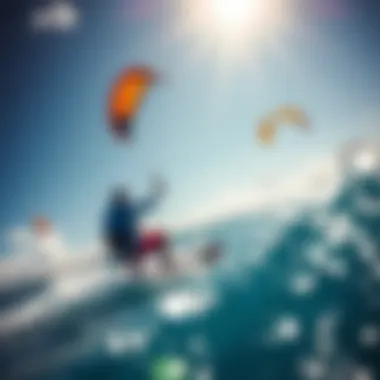
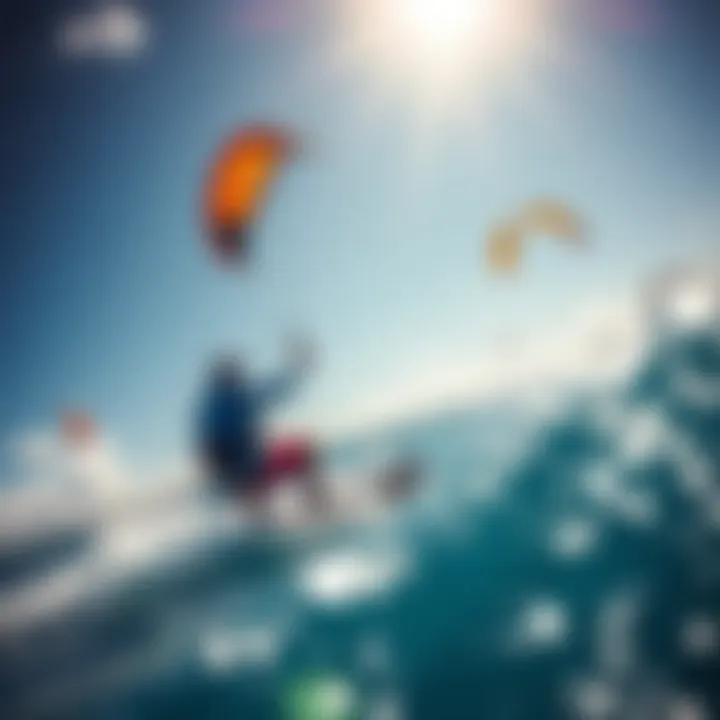
Intro
Kiteboarding isn’t just another water sport; it’s a thrilling interplay between wind and water, artistry and athleticism. Amidst this backdrop, crazy kites emerge not merely as tools but as symbols of creativity and personal expression. These kites, adorned with imaginative designs and patterns, tell stories that resonate deeply within the kiteboarding community. For enthusiasts, they evoke nostalgia, excitement, and an unquenchable thirst for adventure.
In this exploration, we’ll pull back the veil on the intricate world of these unique kites, diving into their cultural significance and the role they play in shaping the sport’s evolution. From examining the craftsmanship behind these flying canvases to understanding the community’s shared passion, we aim to provide a comprehensive overview that captivates both budding kiteboarders and seasoned veterans alike.
Before we launch into the vivid tapestry of kite designs and the stories they encapsulate, it’s essential to lay the groundwork. An understanding of both gear and safety practices can vastly enhance one’s kiteboarding experience, elevating the performance and safety aspects.
Gear and Equipment
To ride the waves seamlessly, a kiteboarder needs the right equipment. What you choose can significantly affect your experience on the water. Here, we'll discuss the fundamentals of kiteboarding gear, tailored for both newcomers and seasoned riders.
Essential Kiteboarding Gear for Beginners
For those just dipping their toes in the water, acquiring the necessary gear is crucial. Here's a rundown of essential items:
- Kite: The most critical piece of equipment. Newbies should consider a forgiving, inflatable kite that offers stability.
- Control Bar and Lines: This is your connection to the kite. Opt for a bar that feels comfortable in your grip.
- Board: There are various types, but a twin-tip board is often recommended for beginners.
- Harness: Select a model that suits your style and offers maximum support. A seat harness may be easier for new riders while waist harnesses offer a more streamlined experience.
- Safety Equipment: A helmet and impact vest can protect you while you learn.
Advanced Equipment for Experienced Riders
Once you've caught the kiteboarding bug, investing in advanced gear can take your skills to new heights. Here are some must-haves:
- High-Performance Kite: Look for advanced kites designed for specific wind conditions and your riding style, such as freestyle, wave, or race kites.
- Board Upgrades: If you've mastered the basics, explore directional boards or lighter models for trick performance.
- Specialized Harness: Comfort and mobility are key. A harness with a slider can provide more freedom when performing tricks.
- Enhanced Safety Gear: As you push your limits, consider additional safety gear, like impact shorts or a buoyancy aid.
With a solid understanding of equipment tailored for every level, kiteboarders can embark on their journeys with confidence. Next, let’s navigate through the techniques and tips that not only ensure safety but also enhance skills on the water.
Techniques and Tips
While gear plays a fundamental role, mastering kiteboarding is equally about technique. Here, we discuss important safety practices and training techniques.
Safety Practices for Kiteboarding
Before and during kiteboarding, keeping safety in mind is paramount. Here are key safety precautions:
- Know Your Environment: Familiarize yourself with the local water conditions, wind patterns, and potential hazards.
- Wind Conditions: Ensure you understand the wind forecast and how it impacts kiteboarding.
- Buddy System: Always kite with a friend. Not only is it more enjoyable, but it also adds a layer of safety.
Training Techniques to Improve Your Skills
Once safety is in place, refining skills is the next step. Consider incorporating the following training techniques:
- Practice on Land: Spend time learning how to control the kite on the ground before hitting the water.
- Frequent Short Sessions: Shorter, more frequent sessions can be more beneficial than long, exhausting ones.
- Learn from Others: Watching experienced kiteboarders can teach you valuable techniques. Consider joining local clubs or communities.
“The wind is your friend, but respect its power and teach yourself to dance with it.”
As we explore the cultures around kites and their significant presence in the kiteboarding landscape, it becomes clearer how these vibrant expressions turn sport enthusiasts into a tightly-knit family—all connected through the love of the craft.
The Evolution of Kites in Water Sports
The world of kites has evolved far beyond mere child's play. The inception of kites in various cultures laid the groundwork for profoundly transformative activities—like kiteboarding. The evolution of kites within water sports represents not only innovations in technology but a bridge connecting nature, culture, and exhilarating physical activity. Understanding this evolution can reveal the essence of kiteboarding; it is not just a sport, but rather a narrative steeped in history and creativity.
Historical Context
Kites first took flight over 2,000 years ago in China, primarily used for military purposes or as signaling devices. They served practical functions such as measuring distances and testing wind conditions. As the years passed, these devices transitioned from the battlefield to leisure, adopted by various cultures worldwide. In Japan and India, kites reflected their artistic essence through intricate designs and techniques, becoming a symbol of celebration and community.
The modern application of kites in water sports began in the late 20th century. The fusion of traditional kite design with advances in materials and aerodynamics yielded kites that could harness wind power in ways previously unimagined. This transformation was monumental, as enthusiasts redefined kites from simple toys to engines of propulsion, leading to the birth of kiteboarding.
"Kites are the embodiment of man's desire to conquer the skies; their evolution mirrors our pursuit of adventure across water and wind."
The Transition to Kiteboarding
The transition to kiteboarding was sparked by the perfect storm of innovation and passion. The ‘90s witnessed groundbreaking designs and techniques, where pioneers like Bruno Legaignoux and Cory Roesler pushed boundaries, merging surfing and kiting into a single exhilarating experience. Kiteboarding differed from traditional kitesurfing in that it offered a more dynamic interaction with both wind and water. Riders could not only glide but also soar, performing tricks and aerial maneuvers that inspired the imagination.
The essence of the sport lies in two critical elements: control and thrill. The development of control bars, safety releases, and better lines enhanced the rider's ability to manage their kite, thereby increasing safety and performance. The advent of inflatable kites added to this versatility, allowing for more compact storage and easier handling, making the sport accessible to enthusiasts of various skill levels.
Today, kiteboarding has turned into a global phenomenon, with international competitions, dedicated communities, and a profound connection to the environment, where the waters meet the skies. Each new design and iteration adds to a grand tapestry woven by countless individuals sharing their passion along coastlines and lakes worldwide.
Defining Crazy Kites
Understanding what constitutes a crazy kite is crucial for anyone keen on kiteboarding. Crazy kites aren’t just any form of equipment; they represent a blend of creativity, innovation, and spirited engagement with the elements. In this discussion, we’ll explore how these unique creations shape both the experience and culture of kiteboarding.
Characteristics of Crazy Kites
Crazy kites stand out in the diverse landscape of kiteboarding due to several defining features. Here’s a closer look:
- Unique Designs: Crazy kites often boast eye-catching designs that go beyond traditional shapes. From fantastical creatures to abstract art, the visual appeal is paramount. The bold colors and unconventional forms serve not only as a personal expression but also as a performance tool.
- Dynamic Performance: Unlike standard kites, crazy kites are engineered for versatility and responsiveness. Their designs often allow for higher jumps, rapid turns, and impressive tricks, making them favorites among thrill-seekers looking for that adrenaline rush.
- Varied Sizes: These kites come in a range of sizes, catering to different wind conditions and rider preferences. The size can significantly affect their performance, and riders often have multiple kites to adapt to changing weather.
- Customization: Many kiteboarders personalize their crazy kites, embedding individual touches into their design. This aspect of customization not only reflects the rider’s personality but also affects the kite’s aerodynamics and handling.
Popular Types of Crazy Kites
When it comes to crazy kites, variety is the name of the game. Here are some notable types:
- Foil Kites: Renowned for their adaptability and performance, foil kites inflate with air and feature a unique structure that allows them to fly efficiently in lighter winds. They’re perfect for tricksters seeking flexibility in various conditions.
- Leisure Kites: Often seen in festivals, leisure kites prioritize creative design over performance. These kites might be whimsical representations of animals or other fun shapes, appealing to beginners or those enjoying the aesthetic aspects of kiteboarding.
- Stunt Kites: As the name suggests, these kites are all about action. They are designed to perform tricks and are typically smaller, allowing for quick maneuvers. Riders often engage in competitions showcasing their skills with these kites.
- Single-line Kites: Simplistic yet intriguing, single-line kites flash vibrant colors against blue skies and can pull the attention of onlookers. They are not usually used for kiteboarding but are often part of kite festivals, adding to the overall atmosphere of fun.
"Kites are not just about flying; they're about expression and pushing beyond the conventional limits of what you can do on water."
Each of these types serves its purpose while embodying the spirit of fun and adventure that characterizes crazy kites. As we navigate through this journey of discovery, defining the elements that comprise these fascinating creations helps enthusiasts grasp how they fit into the broader narrative of kiteboarding culture.
Cultural Significance of Kites
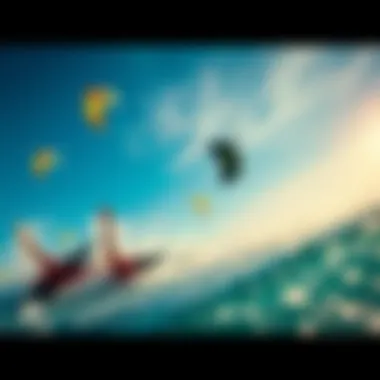
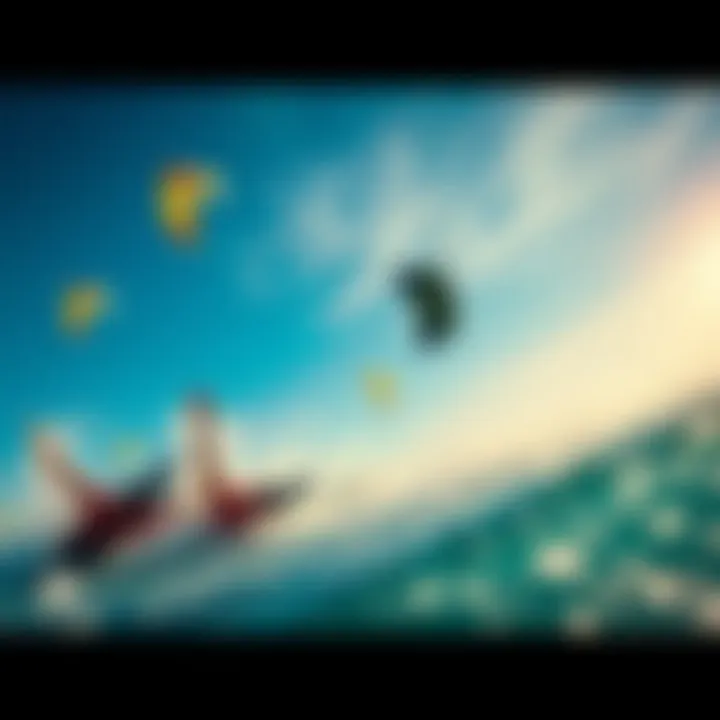
Kites carry a profound cultural weight across various societies, acting as more than just colorful objects floating in the sky. They embody the spirit of a community, encapsulating traditions, stories, and even the essence of a region's identity. In the kiteboarding realm, crazy kites reflect not only the creativity of their makers but also the cultural narratives woven into their designs. The significance of kites in the cultural landscape is evident in festivals, historical practices, and the shared joy they bring to diverse audiences.
The importance of crazy kites extends beyond their functionality; they are a bridge between generations. Enthusiasts often recount tales of their first kite experiences, highlighting the nostalgia and sense of freedom that comes with flying a kite. This connection to childhood memories binds people together, creating a shared identity within the kiteboarding community.
"Kites take us back to a simpler time, where whimsy meets adventure in the most beautiful way."
Kite Festivals Around the World
Kite festivals serve as vibrant celebrations of culture and creativity. In places like India, the festival of Makar Sankranti marks the arrival of spring, during which large gatherings take place. Kites of every shape, size, and color fill the sky, symbolizing hope and new beginnings. Participants engage in friendly competitions, with the ultimate goal of cutting the strings of opposing kites in what is called "kite fighting." The atmosphere is charged with excitement, as people cheer and share tips with each other while navigating the winds.
Another notable festival is the International Kite Festival in Berck-sur-Mer, France. This event draws kite fliers from around the globe, showcasing stunning displays that push the limits of kite design and artistry. From giant inflatable creatures to intricate, artistic representations, the festival highlights innovation and community spirit. Unsurprisingly, kiteboarding has also found its niche in these events, inspiring younger generations to take up the sport.
The essence of these festivals is not only rooted in fun but also in cultural exchange. Kite festivity serves as a conduit for showcasing local traditions while embracing new influences. As kite enthusiasts gather, they share techniques, stories, and their love for kites, enriching communal ties.
Traditional vs. Modern Kites
Kite making and flying have evolved dramatically over the years, reflecting broader societal changes. Traditional kites, often crafted from natural materials like bamboo and rice paper, tend to feature local designs influenced by cultural stories or symbols. For instance, in East Asia, dragon kites are not just for show; they symbolize power and strength and are believed to bring good luck.
In contrast, modern kites embrace innovation through new materials such as ripstop nylon and advanced design techniques. Manufacturers focus on functionality and performance, shaping kites that are responsive and durable. These kites often incorporate bright colors and eye-catching designs, pushing the boundaries of aesthetics.
The distinction also lies in the approach to kite flying. Traditional practices usually involve communal participation, with families gathering to engage in kite-making and flying. In modern settings, individualism often takes the lead, as outdoor instructors or athletes push personal limits in kiteboarding competitions.
Nevertheless, both traditional and modern kites celebrate creativity and human ingenuity. They symbolize the art of flight, each pursuing the same dream of soaring through the skies while carving out unique paths in their narratives.
The Engineering Behind Crazy Kites
When it comes to kiteboarding, the term ‘crazy kites’ isn’t merely a catchy label; it signifies a significant step in the evolution of kite design and performance. The engineering behind these extraordinary flying machines embodies a fusion of creativity, functionality, and performance that sets them apart in the sport's tapestry. Understanding how these kites are engineered holds the key to unlocking their potential, ensuring safety, and enhancing the exhilarating experience that kiteboarding offers.
Materials Used in Kite Construction
Choosing the right materials is akin to laying the foundation for a house. It is crucial for durability and efficiency. Most crazy kites incorporate a variety of fabrics like polyester, nylon, and ripstop, each chosen for its unique properties.
- Polyester: Often favored for its ability to resist water absorption and UV degradation, ensuring longevity.
- Nylon: Emphasized for its strength and lightweight nature, nylon often aids in achieving a faster flight.
- Ripstop fabric: This material features a crosshatch pattern designed to prevent tears from spreading, crucial for a sport where high winds are common.
Beyond just fabrics, the frame used in construction typically involves materials like fiberglass or aluminum, providing a balance of lightness and strength. The strategic combination of these materials leads to kites that can withstand the rigors of intense kiteboarding yet remain light enough for optimal performance. Additionally, some newer models incorporate eco-friendly materials, aligning with a growing trend towards sustainability while engaging with exhilarating outdoor sports.
Innovative Design Techniques
In the realm of kite engineering, innovation is the lifeblood propelling kite designs to dizzying heights—literally. As kiteboarding evolves, so too do the techniques used to design these kites.
One notable approach is the use of computer-aided design (CAD) and wind tunnel testing. With CAD programs, designers can craft shapes and predict how a kite will interact with wind in various conditions before ever cutting fabric. This not only streamlines the design phase but also minimizes waste.
Another cutting-edge technique involves three-dimensional (3D) modeling for optimal aerodynamic efficiency. By analyzing airflow dynamics through 3D models, engineers can adjust shapes for smoother flight patterns and improved stability—a game-changer when you’re in a battle with ocean currents and gusty winds.
The concept of modular kites is also making waves. Some kiteboarders now have the option to customize kites by swapping out different parts like the canopy or the struts, enhancing their performance based on personal preferences or specific conditions.
"The incorporation of advanced engineering principles in kite design has transformed the recreational pastime into a high-performance sport capable of thrilling enthusiasts and professionals alike."
The Psychology of Color and Design
The art of kiteboarding takes more than just skill and wind conditions; it’s a canvas fashioned by the vibrant colors and innovative designs of the kites themselves. This segment delves into the psychological aspects of color and design, which can significantly influence not only the aesthetics of kites but also their performance and the mood of the rider. Understanding these aspects is essential for kiteboarders, adventure seekers, and anyone involved in the sport.
Impact of Visual Aesthetics on Performance
Visual aesthetics do not merely serve as a feast for the eyes; they can also play a crucial role in performance. Colors can elicit emotional responses and affect concentration. For instance, bright colors like neon green or vibrant pinks can invigorate a rider’s spirit, often enhancing their confidence on the water. Research indicates that colors like red can increase adrenaline and energy levels, making kiteboarders feel more alert and capable during their rides.
Moreover, contrasting designs help in visibility. Brightly colored kites stand out against the waves and sky, allowing both the rider and observers to appreciate their maneuverability. This is particularly important during competitions, where being visually clear can make a notable difference in scoring and safety. An eye-catching kite can attract attention and create an image, establishing an identity within the kiteboarding community.
The strategic use of color patterns can enhance aerodynamic properties as well. Certain designs reduce drag and improve lift by channeling wind more effectively. Thus, from performance-enhancing capabilities to pure artistic expression, the visual elements of kites transcend mere decoration and enter the realm of vital function.
Cultural Interpretations of Colors
Colors hold varied meanings across different cultures, affecting how kites are perceived globally. For instance, in many Eastern cultures, red symbolizes joy and good fortune, often reflecting on the designs of kites used during celebrations. This rich cultural context infuses additional meaning into kiteboarding, especially at international events and festivals where riders might showcase kites inspired by their heritage.
Conversely, in Western cultures, blue often draws associations with calmness and stability. A kite painted in varying shades of blue might resonate differently with an audience, possibly evoking a sense of peace compared to a more energetic color like orange. In regions saturated with festivals, kites not only exhibit the creator's personal touch but also bring together community narratives that bind people through shared experiences.
In addition to cultural significance, there’s an emerging trend of using colors in innovative ways for brand identities. Popular kite brands often adopt distinctive color schemes that become synonymous with their image. This strategy creates a recognizable identity that may influence purchasing decisions among enthusiasts.
Overall, while kiteboarding may often be viewed through the lens of adrenaline and thrill, the psychological impact of colors and design opens up a dialog about the deeper connections we forge with the kites we fly. As riders continue exploring these nuances, their relationship with the sport evolves into something profoundly personal and culturally rich.
Crazy Kites in Competitive Settings
In the realm of kiteboarding, crazy kites are not merely a spectacle; they play a significant role in shaping competitions. From strategy to design, these distinctive kites elevate the competitive scene in several ways. They create an environment where innovation, artistry, and athletic prowess come together, making for an exhilarating experience for both participants and spectators.
Kiteboarding Competitions Featuring Crazy Kites
Various kiteboarding competitions embrace the use of crazy kites, showcasing not only the skill of the athletes but also the flair of their equipment. Events like the Kiteboarding World Cup and the Red Bull King of the Air are platforms where competitors dazzle audiences with their unique kite designs. Crazy kites often feature bright colors, unusual shapes, and intricate patterns, providing an eye-catching backdrop to thrilling performances.
One notable example is the annual Kite Masters competition, held in Cape Town. Here, participants often customize their kites, pushing the envelope of traditional kite design. This competition not only highlights the athleticism of the riders but also encourages designers to experiment with new materials and shapes, which can significantly affect performance in varying wind conditions.
"The use of crazy kites in competitions demonstrates that creativity is just as influential as skill when it comes to kiteboarding success."
These events serve as a global stage for riders to showcase their talents, often leading to innovative kite designs that could set trends for future competitions.
Notable Athletes and Their Contributions
Within the kiteboarding community, certain athletes stand out for their unique contributions to the sport and the evolution of crazy kites. Youri Zoon, a multiple-time world champion, is renowned for his aerial tricks and the custom designs of his kites, which often incorporate cutting-edge technology and aesthetics. His dedication to kite innovation not only sets a benchmark for upcoming riders but also inspires kite makers to think outside the box.
Another influencial figure is Linda Perrin, known for her dedication to sustainability in kite design. She blends artistic vision with eco-friendly materials, proving that performance and environmental consciousness can coexist. Her participation in competitions has pushed discussions on sustainable practices in the kiteboarding community, encouraging others to consider the impact of their designs.
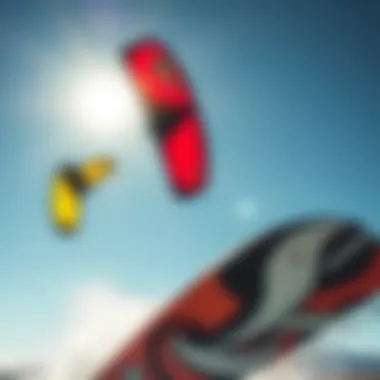
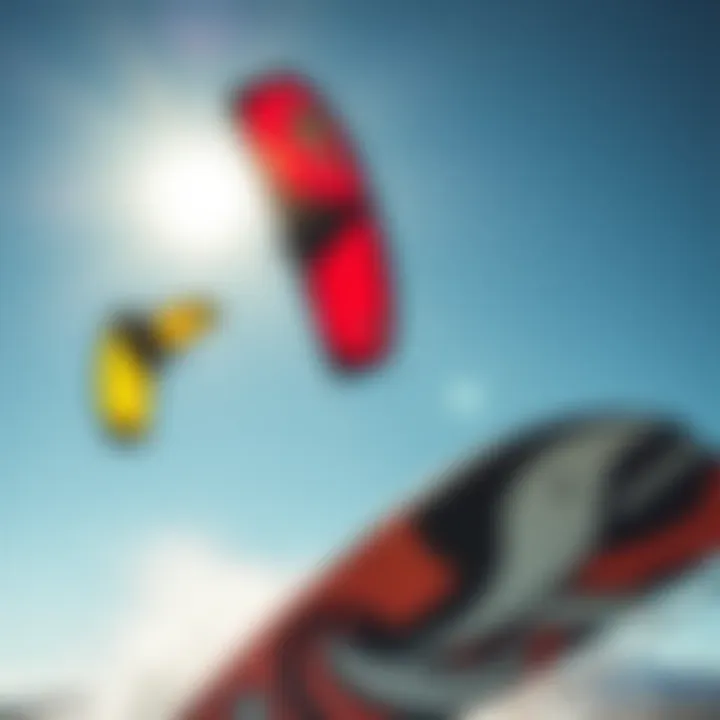
Additionally, the rise of social media has allowed these athletes to reach a wider audience. They share their experiences, designs, and techniques online, fostering a community enthusiastic about both competitive excellence and creative kite-making. As they innovate and share their stories, the gap between competition and community continues to strengthen, making the world of crazy kites more dynamic.
The interplay of creativity and competition in kiteboarding, reflected through the lens of crazy kites, creates an environment ripe for advancement and camaraderie among kiteboarding enthusiasts.
Community Engagement with Crazy Kites
Community engagement plays a significant role in the world of crazy kites, particularly within kiteboarding. This form of interaction fosters a sense of belonging among enthusiasts and promotes the sharing of knowledge and experiences. It can drive innovation in designs and techniques, ensuring the sport continues to evolve. Engaging with others who share a passion for crazy kites can lead to collaboration on projects, whether it’s in construction processes or participating in events.
Social Media and Digital Presence
In the age of digital communication, social media serves as a critical platform for kiteboarders to connect, share, and showcase their crazy kites. Platforms like Instagram and TikTok allow users to post photos and videos of their kiteboarding adventures, creating visually engaging content that can inspire others. Hashtags such as #CrazyKiteboarding and #KiteLife serve to unify posts, making it easier for enthusiasts to find each other and share their experiences.
Social media also enables kiteboarding communities to discuss trends, seek advice, and share tips. Many riders also use these platforms to promote upcoming events, ensuring better participation and broader outreach. For instance, riders may announce meetups or competitions that encourage local kiteboarding communities to come together.
Furthermore, influencers and professionals frequently contribute to discussions, providing insights and advice that help shape the community’s understanding of kiteboarding and gear. These interactions can enhance skills and inspire others to push their boundaries. In sum, a robust digital presence can catalyze greater involvement in the kiteboarding world.
The Role of Online Forums and Groups
Online forums and groups act as a sanctuary for kiteboarding enthusiasts to dive into detailed discussions about crazy kites and their nuances. Websites like Reddit and various specialized forums provide platforms where members can ask questions, post tutorials, and share personal stories related to kiteboarding. This space not only fosters learning but also builds camaraderie among users who may never meet in person.
In these forums, members often exchange information about the latest kite designs, suitable locations for kiteboarding, and safety tips. For instance, a member might describe a recent trip to a hidden beach known for its excellent wind conditions, providing fellow riders an opportunity to explore new spots. These interactions enhance the kiteboarding experience and allow individuals to grow collectively as a community.
Interestingly, some forums also organize virtual challenges and contests that keep the competitive spirit alive among members, regardless of geographical distances. This sense of collective engagement creates a rich tapestry of experiences and knowledge that benefits everyone involved.
"The kiteboarder's community thrives on shared experiences, both in the physical world and online, strengthening our ties and promoting the sport we love."
Engaging with others around the topic of crazy kites is vital. It not only makes the kiteboarding experience richer but also reinforces the social fabric of the community, blending personal achievements with shared passions.
Environmental Considerations
Environmental considerations bear significant weight in the realm of kiteboarding, particularly when one looks at the rising tide of awareness surrounding sustainability. As kiteboarding continues to grow in popularity, the industry is challenged to bridge the gap between exhilarating experiences and the health of our planet. This section aims to uncover how kite creators and enthusiasts alike are uniting to foster environmentally conscious practices without sacrificing the thrill of the sport.
Sustainable Materials in Kite Production
The conversation around sustainable materials in kite production is taking flight. Manufacturers are exploring a palette of materials that not only enhance performance but also minimize the ecological footprint. Nowadays, you might find kites made from recycled plastics or bio-based fabrics. For example, some brands have begun using repurposed PET, made from discarded plastic bottles, setting a clear path toward cleaner production methods. Not only does this divert waste from landfills, but it also reduces reliance on virgin materials.
- Eco-friendly Fabrics: Manufacturers are increasingly sourcing fabrics such as ripstop nylon and polyester that are produced with a lower environmental impact.
- Biodegradable Components: Initiatives focusing on integrating biodegradable parts into kites are fueling further innovation.
- Lighter Materials: Utilizing lighter materials aids not just in performance but also in reducing fuel emissions during transportation.
As kite enthusiasts advocate for eco-friendly products, they also aid in raising awareness among novices and seasoned kiteboarders. The movement towards sustainable kite production symbolizes a collective aspiration towards enjoying the sport while nurturing the environment.
Minimizing Environmental Impact
Minimizing environmental impact in kiteboarding calls for thoughtful practices, both on and off the water. Crafting an eco-conscious approach can take shape in many subtle yet significant ways. It’s crucial for the kiteboarding community to adopt habits that protect the natural landscapes we cherish.
- Responsible Riding Locations: Choosing to ride at designated kiteboarding spots can help preserve untouched natural areas. Being mindful of local wildlife can make a world of difference.
- Proper Disposal of Gear: When your kite reaches the end of its life, it’s vital to recycle or properly dispose of it. Many regions now have programs that can handle such materials, preventing them from polluting oceans or beaches.
"Kites may soar high, but a true kiteboarder keeps their feet grounded in the reality of their environmental responsibilities."
- Community Clean-ups: Joining or organizing beach clean-ups not only aids in preserving the environment but also builds camaraderie among kiteboarders and uplifts the community spirit.
- Educational Outreach: Sharing knowledge about sustainable practices within kiteboarding circles fosters a culture of environmental stewardship and innovation, ensuring the next generation of kites are made with tomorrow’s needs in mind.
In summary, environmental considerations are not merely an afterthought in kiteboarding, but instead are integral to shaping a community where the thrill of the ride goes hand in hand with a commitment to protect the natural world. As kite enthusiasts embrace sustainable practices and innovative materials, they pave the way for a future that honors both adventure and our planet.
The Future of Crazy Kites in Kiteboarding
The landscape of kiteboarding is ever-evolving, and the future of crazy kites holds a special significance in this dynamic world. As kiteboarding technology advances and creative designs emerge, we see a wave of innovation that promises not only enhanced performance but also a more inclusive and engaging experience for enthusiasts. The infusion of emerging materials, exciting design principles, and the influence of community engagement are all unfolding narratives that shape the future of this sport. Understanding these elements allows kiteboarders to stay ahead of the curve while also appreciating the cultural tapestry that supports this thrilling pastime.
Emerging Trends in Kite Design
The kite design arena is thriving with trends that blur the lines between functionality and artistic expression. One of the most noticeable directions is the increasing inclination towards eco-friendly materials. Kite manufacturers are beginning to explore fabrics made from recycled plastics and biodegradable substances. This is not just about performance; it speaks to the growing awareness in the kiteboarding community about environmental stewardship. Kite designs are getting more aggressive in shapes, with broader wingspans and intricate pattern work that captivates onlookers and functions effectively in diverse wind conditions.
- Sustainable Fabrics: Options like Ripstop nylon treated with eco-friendly coatings make their way into mainstream designs, enhancing durability and reducing environmental impact.
- Inflatable Shapes: Innovations in inflatable designs allow for customizable shapes and improved aerodynamics, maximizing lift and minimizing drag.
- Modular Designs: Expect to see more kites that can be easily configured or swapped out for different styles or conditions. This flexibility empowers riders to tailor their kites to their personal preferences.
The aesthetics of kiteboarding gear are also transforming. Riders now favor personalization options that showcase individual style, leading to more vibrant and diverse kite profiles across the water. Moreover, digital technologies are integrating with kite design. 3D printing technology is on the brink of revolutionizing how kites are crafted, allowing for precise parts that optimize the relationship between materials used and kite performance.
Predictions for the Kiteboarding Industry
As we gaze into the future of kiteboarding, it is clear that several trends are likely to drive the industry forward:
- Increased Accessibility: More companies are focusing on creating entry-level kites that cater to newcomers while providing the technical options that seasoned riders crave. This may open doors for a wider audience, introducing many newcomers to the sport.
- Enhancement in Safety Features: According to various kiteboarding forums, safety will continue to be a major priority. Protoypes involving quick-release mechanisms and automatic depower features are set to become industry standards.
- Rise of Electric-Powered Kites: There are whispers about integrating electric propulsion systems, offering riders an alternative way to harness wind power and providing new dimensions to the sport. Projections suggest that this could enhance the kiteboarding experience even in lower wind conditions.
**“In the next five years, we expect to witness a renaissance in kite design, incorporating sustainability with advanced technology. The future is bright for kiteboarding enthusiasts.
Building Your Own Crazy Kite
Creating your own crazy kite can be one of the most rewarding experiences for a kiteboarding enthusiast. This section will explore why building your own kite is significant and highlight the elements you need to consider when getting started.
The act of making a kite is not just about the end product. It allows you to engage with the kiteboarding community on a personal level. You can express your creativity through the designs and colors you choose. Plus, you develop a deeper understanding of aerodynamics, materials, and the physics involved in kiteboarding. These things can enhance your overall skills out on the water.
However, there are practical benefits too. A custom kite can be tailored to your specific riding style and local conditions. For example, if you often find yourself in high winds, adjusting your kite's size or shape can make a world of difference. Moreover, crafting a kite from scratch often ends up being more cost-effective than purchasing high-end, commercial options.
Basic Principles of Kite Making
When it comes to making your own crazy kite, understanding the basic principles is crucial. First off, you need to familiarize yourself with the fundamental components: the frame, the sail, and the bridle.
- Frame: This provides structure and must be sturdy yet light. Many kite builders opt for materials like fiberglass or carbon fiber for optimal durability.
- Sail: The material for the sail plays a massive role in the kite's performance. Nylon and polyester are popular choices due to their balance of weight and strength.
- Bridle: This connects the kite's frame with the lines and is vital for ensuring the kite flies straight. A well-designed bridle can significantly improve performance.
Before cutting or assembling any materials, sketching out your design is a wise move. Consider the size and shape that best fits your riding style and conditions. A simple diamond shape might be excellent for beginners, while more experienced riders might prefer a delta or hybrid design to adapt to a variety of situations.
Advanced Techniques for Customization
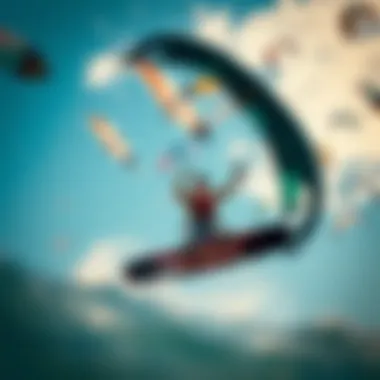
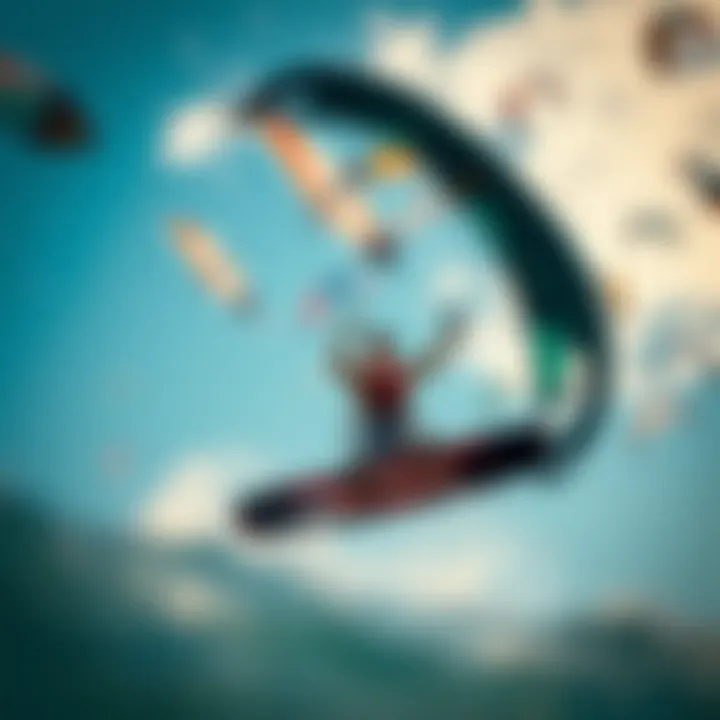
Once you grasp the basics, diving deeper into advanced techniques can refine your kite even further. Customization can truly make your kite feel like an extension of yourself.
- Shape Adjustment: Experimenting with the leading edge and tail can alter how your kite handles in the air. If you elongate the leading edge, it will change the lift characteristics, potentially allowing for higher jumps.
- Fabric Layering: Consider using different fabric types for various sections of the sail. For example, a lightweight material could be on the top for speed, while more robust fabric might be placed on the bottom side to withstand pressure and abrasion.
- Graphic Design: Incorporating visual flair such as vibrant colors or unique patterns not only personalizes your kite but can also influence its visibility on the water. A bright design helps you stand out, especially in crowded kiteboarding areas.
"A kite is not just a piece of fabric; it's an expression of who you are as a rider. Building one speaks to your creativity and understanding of the sport."
As you start customizing, remember to keep safety in mind. Test your kite in controlled environments before taking it into adverse conditions. This practice can prevent mishaps and help you learn the kite's capabilities.
In the end, building your own crazy kite is not just about functionality. It’s about the journey of learning and the community you connect with while sharing your passion.
For further reading and resources, visit:
- Kiteboarding.org
- Kiteforum.com
- For more details on kite engineering, check out National Geographic
- Interested in the latest designs? Find inspiration on Pinterest
Safety Considerations
Engaging with kiteboarding is an adventure that promises thrills, yet it’s crucial to remember the safety measures that accompany this exciting sport. Riders must recognize that the very elements that create exhilarating experiences, such as winds and waves, can pose significant risks if not managed properly. Safety considerations are not just recommendations; they are essential practices that ensure participants can enjoy this sport without unnecessary danger.
Understanding Wind Conditions
Wind is the lifeblood of kiteboarding, driving the kites high into the air and pulling riders along the water’s surface. However, navigating the nuances of wind conditions is a skill that cannot be overlooked. Understanding wind patterns and their variability can make the difference between a memorable session and a perilous one.
Factors to consider when evaluating wind conditions include:
- Wind Speed: Ideal speeds for kiteboarding typically range from 12 to 25 knots. Anything significantly lower can lead to a lack of control, while too much wind can overshoot safety limits.
- Wind Direction: Be aware of the direction you’re riding into, as onshore winds can pull you towards the beach while offshore winds can sweep you out to sea.
- Turbulence: Look for signs of turbulent wind, such as shifting direction, gusts that abruptly change speed, or chaotic patterns in the water, all of which could signal danger.
"Experience is the best teacher, but understanding the wind should be your first lesson in kiteboarding."
Riders should know that the conditions can change rapidly, especially near shores or cliffs. Regularly checking local wind forecasts on platforms like Windy or consulting with local kiteboarding communities on forums like Reddit can enhance your understanding and preparedness.
Kiteboarding Safety Gear
Accompanying a solid understanding of wind conditions, the right safety gear serves as a buffer against potential hazards in kiteboarding. Ensuring that you’re equipped with the best safety gear is not just wise but a necessity. Here’s a breakdown of fundamental gear:
- Personal Flotation Device (PFD): A well-fitting PFD can be a lifesaver, offering buoyancy and keeping riders afloat even in challenging circumstances.
- Helmet: Protect your head from unintended collisions with the kite, other riders, or the water's surface.
- Impact Vest: This piece protects the torso during falls while also providing extra flotation, a benefit not to be overlooked.
- Leash Systems: Ensure your kite is securely attached with a reliable leash. A good leash prevents separation between the kite and rider in case of unexpected events.
- Safety Release Mechanism: Familiarize yourself with how to activate safety releases on your kite, as quick response to potential malfunctions is critical.
Investing in quality gear pays dividends for both safety and performance. Many enthusiasts recommend brands like Naish or Duotone for their reputation in providing robust safety features in their kiteboarding equipment.
For a more detailed overview on selecting safety gear, you can visit Kiteboarding Safety Gear.
In summary, prioritizing safety considerations empowers kiteboarders to navigate the sport intelligently. Understanding wind conditions and utilizing appropriate safety equipment not only enhances experiences but fosters a culture of responsible kiteboarding within the community.
Academic Research on Kites and Kiteboarding
Research into kites and kiteboarding serves multiple purposes, highlighting their evolution and increased prevalence in modern sporting activities. Such academic inquiry not only furthers our understanding of the mechanics of kite design but also elucidates the impact of psychological factors on performance among kiteboarders. Understanding these aspects can enhance the experience for enthusiasts and contribute to more informed practices within the sport, ensuring safety and maximizing enjoyment.
Studying the Mechanics of Kites
The study of kite mechanics involves a thorough exploration of how kites interact with environmental elements, particularly wind. Kite design plays a pivotal role in harnessing these forces to provide lift and control. Key physical principles at play include:
- Aerodynamics: The shape and size of a kite significantly influences its flight capabilities. Variations in design can lead to vastly different performance outcomes, with some kites being better suited for speed while others excel in stability.
- Tension and Stability: The materials used in a kite's construction influence both its durability and ability to withstand motion. Layers of different fabrics can alter the kite's weight distribution, affecting performance in diverse wind conditions.
- Bridle Systems: The arrangement of lines and attachments significantly determines how a kite responds in the air, which is crucial for kiteboarding.
Understanding these mechanics not only supports the core functionality of kites but also inspires innovations in design for improved user experience.
Impact of Sports Psychology on Kiteboarding
Mental aspects of performance in kiteboarding often get overlooked, yet they play an essential role in the overall experience. Research in sports psychology can reveal how various factors influence a kiteboarder's mindset, particularly during high-pressure competitions. Things to consider include:
- Confidence and Anxiety Levels: Familiarity with kite technology and local conditions can significantly affect a kiteboarder’s confidence. Knowing how to handle diverse situations leads to improved performance and reduced anxiety, particularly in competitive settings.
- Focus and Concentration: Kiteboarding requires acute mental focus, especially during aerial maneuvers. Distractions can be detrimental, and psychological training can improve concentration, thereby optimizing performance.
- Team Dynamics: For competitive kiteboarding, team interactions can influence an athlete’s mental state. Research suggests that supportive environments can enhance performance through shared knowledge and encouragement among peers.
Through academic inquiries into these psychological factors, kiteboarding enthusiasts can refine their approach to practice and competition, yielding a more fulfilling and safe experience on the water.
"In kiteboarding, understanding the mechanics is just as crucial as mastering the mental game. Both play a significant role in one’s success in the sport."
To deepen your understanding and curiosity, you may explore resources like Wikipedia for a foundational overview or peruse studies on Britannica that delve into the intricacies of kite mechanics and psychological influence.
Key Takeaways for Kiteboarding Enthusiasts
Understanding the captivating world of crazy kites is pivotal for both seasoned kiteboarders and newcomers alike. These unique kites not only add flair but also enhance the overall kiteboarding experience. Engaging with them can open up a multitude of avenues, both in terms of performance and personal expression while gliding over the water.
One of the first things enthusiasts should take away is the significance of creativity in kite design. Crazy kites often showcase bold colors and wild shapes, reflecting the personality of the rider and the culture of kiteboarding. This means that selecting a kite isn’t just a matter of function but also about self-expression and connecting with the kiteboarding community.
Furthermore, understanding the mechanics of different kite types can drastically improve a kiteboarder’s performance. Whether you are considering an inflatable kite for beginners or a surf kite for the experienced rider, knowing how each kite performs in distinct wind conditions can lead to safer and more thrilling experiences.
Here are some practical elements and benefits to keep in mind:
- Performance Variability: Different designs can influence speed and maneuverability. Enthusiasts should familiarize themselves with how shape and size affect handling and responsiveness.
- Cultural Connection: Crazy kites embody local traditions and global trends. Appreciating these ties can foster a deeper connection within the kiteboarding community.
- Environmental Awareness: As kiteboarding grows, so does the need for sustainable practices. Engaging with eco-friendly materials not only benefits the planet but also enhances the sport’s reputation.
"The right kite can make a world of difference in kiteboarding, both in terms of safety and fun."
Overall, the takeaways from exploring crazy kites focus on understanding the interplay of design, performance, and community engagement. These factors combine to create an enriching experience for kiteboarders at all levels.
Practical Tips for Engaging with Crazy Kites
When it comes to engaging with crazy kites, practical steps can make a significant impact on your kiteboarding journey. Here are some useful tips:
- Research Designs: Before choosing a kite, spend time researching its design features. Look for reviews and feedback from other kiteboarders to determine what best fits your style and needs.
- Join Local Communities: Connect with local kiteboarding groups or online forums. This is a great way to find information on the latest trends and useful techniques from fellow kite enthusiasts.
- Attend Workshops and Events: Participating in kite workshops or attending kite festivals can provide insight into the craftsmanship behind crazy kites and potentially spark inspiration for your own creations.
Integrating Crazy Kites into Your Kiteboarding Experience
Integrating crazy kites into your kiteboarding experience is not just about having a unique design. Here’s how you can enhance your time on the water by adopting these kites:
- Tailor Your Sessions: When heading out, think about the type of experience you want. Whether it’s cruising or doing tricks, your kite choice should align with your ambitions that day.
- Experiment with Different Kites: Don’t shy away from trying various kites. Each provides a distinct feel and understanding of how they interact with the wind, helping you to refine your skills.
- Document Your Progress: Capture your sessions on video or through photos. Tracking your engaging experiences with crazy kites allows you to understand how to refine your techniques and discover what works best for you.
Adopting these approaches can foster a greater enjoyment of the sport, while also building connections with others who share your passion. Whether you find fun through design or performance, crazy kites can significantly enrich your kiteboarding journey.



